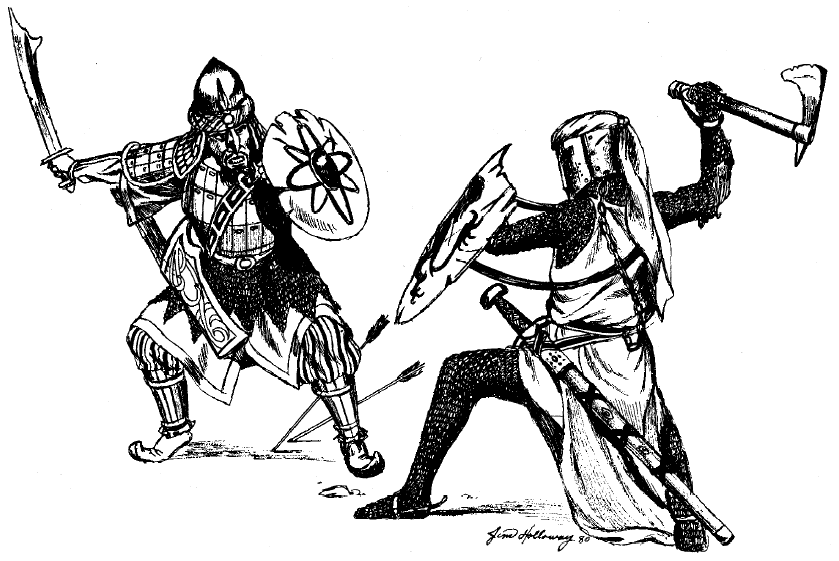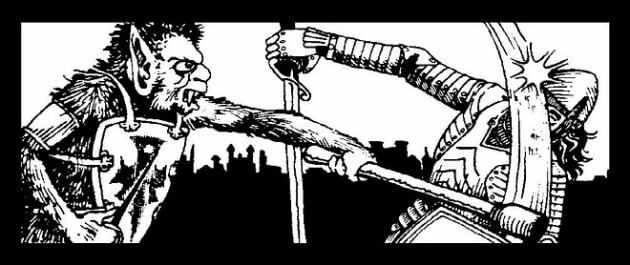With this series we aim to make it easier for new players to get a grasp on how combat works. Now that we are talking about actions we come to the point of it all, the one thing you do in a combat scenario that makes it a combat, the Attack action! Whether swinging your sword, slinging a spell, or flinging a bolt from a crossbow, it’s all a part of the Attack action. There are lots of different ways to make attacks, but they all make an attack roll. Let’s see what makes up an attack roll and what you can do with it.
Table of Contents
Making An Attack Roll
First let’s look at what makes up an attack roll and we will get into what kind of attacks there are after that. To make an attack roll we are going to use a 20 sided die, called a d20. The d20 is the base of the Dungeons & Dragons system and will be used for the majority of your rolls. When you make your attack roll, you are trying to roll a number that will meet or exceed your target’s Armor Class, also known as their AC. We will explain what goes into determining your Armor Class in another article. To do this you will also have an attack modifier that is added to your d20 roll.
There are two things that make up your attack modifier. It is the sum of your attack ability modifier and your proficiency bonus. Your attack ability modifier is the modifier for whichever ability score your attack is using. This will be either Strength or Dexterity, depending on what kind of attack you are making. I’ll explain those differences after this. Your proficiency bonus is a predetermined number that increases when you advance to certain levels. As both of these numbers increase through leveling up and ability score improvements, your attack modifier will increase, making it easier for you to hit enemies with a high AC.

Types Of Attacks
In a fight, attacks are made with a wide variety of weapons and abilities. The type of weapon will determine which stat is used for the attack, either Strength or Dexterity. There are also a few special actions that can be used as your attack action, but aren’t intended to do damage to an enemy. Let’s get into it.
Melee
A melee attack is one that is made up close within the reach of the weapon held in your hand. This is when you are right next to an enemy swinging at them with a sword, axe, mace, etc. Every melee weapon will use your Strength ability to determine your attack roll. The means you are using your Strength modifier when adding up your attack bonus. For a melee attack with a weapon your character knows, that means your attack roll will look like this:
1d20 + STR MOD + PROF BONUS
If your character ever wields a weapon that they are not proficient with, you do not get to add your proficiency bonus to your attack roll. There are also some weapons that allow you to use your Dexterity instead of your Strength ability for your attack rolls if you choose. These weapons are able to do so because they have the finesse property. These are generally weapons where dexterous precision can be used just as much as brute force such as a rapier, quarterstaff, or dagger. When using these weapons the attack roll is made the same way, except you would use your Dexterity modifier instead of your Strength modifier.
Ranged
Using a weapon that allows you to attack from a distance is a ranged attack. This includes things like firing a crossbow or hurling something with a sling. Each ranged weapon uses your Dexterity ability to determine your attack roll. This means you are using your Dexterity modifier when adding up your attack bonus. For a ranged weapon attack, that means your attack roll will look like this:
1d20 + DEX MOD + PROF BONUS
Just like with melee attacks, if you ever wield a ranged weapon that you aren’t proficient with, you won’t get to add your proficiency bonus to your attack roll. There are a few weapons that make an exception and allow you to use your Strength ability for a ranged attack. Any melee weapon that has the thrown property can do this. The thrown property allows a weapon to do just that, be thrown at something. When you do this, you use whatever ability is used to make a melee attack with it when you make your attack roll. This means that if a melee weapon has both the thrown and finesse properties, you can use either your Strength or your Dexterity to determine your attack roll. Weapons can have a variety of different properties that dictate how they function. We are just going to focus on relative ones here and will go over those more in-depth in another article.
Grapple
When you use the attack action, you can use a special action to attempt to grapple an enemy instead of dealing them damage. A grapple is where you grab onto an enemy and basically hold them in place. When this is done, both of those involved in the grapple have their movement speed reduced to 0 until the grapple ends. To grapple an enemy, you use your attack action to make a Strength(Athletics) check in an attempt to grab onto them. The enemy gets to contest the roll by making their choice of a Strength(Athletics) check or a Dexterity(Acrobatics) check. If you roll the higher number, then you grab onto your foe and the two of you become grappled. If your target rolls the higher number, they are able to evade your attempt and avoid being grappled by you.
There are just a few restrictions when it comes to trying to grapple something. They have to be within your reach and you have to have a free hand. They also can’t be vastly larger than you. You can grapple creatures that are smaller than you, and you can grapple creatures that are one size larger than you, but can’t grapple creatures larger than that. Also, there are some classes, like the fighter for example, that allow you to make multiple attacks when you use the attack action on your turn. If you are able to make multiple attacks, you may replace each of them with a grapple attempt if you feel like it. Grab onto all the things!
It only takes one hand to grapple a creature, but your other hand is free. You can use it to continue attacking, or anything else you want on your turn. You can also move a creature that you are grappling. When you do, your movement speed is halved unless they are two or more sizes smaller than you.
Shove
There is one more special action that you can take when you use the attack action, the shove. By using your action to shove a creature, you attempt to either shove them back away from you, or to shove them prone. Shoving a creature follows most of the same restrictions as trying to grapple them. They have to be within your reach and they can’t be vastly larger than you. You can shove creatures that are smaller than you, and you can shove creatures that are one size larger than you, but can’t shove creatures larger than that. Also, like grappling, if you are able to make multiple attacks, you may replace each of them with a shove attempt if you feel like it.
To shove an enemy, you use your attack action to make a Strength(Athletics) check in an attempt to shove them back, or to shove them onto the ground.. The enemy gets to contest the roll by making their choice of a Strength(Athletics) check or a Dexterity(Acrobatics) check. If you roll the higher number, then you get to make your choice of shoving your foe 5 feet away from you, or shoving them to the ground making them prone. If your target rolls the higher number, they are able to evade your attempt and avoid being shoved by you. The advantage of shoving a creature prone is that melee attacks have advantage against a prone target, though it does cause disadvantage on ranged attacks. Shoving a creature away from you is advantageous because it allows you to run away from a creature without provoking an opportunity attack.

Opportunity Attacks
The battlefield is fast paced and every combatant is looking for every opportunity to strike. An opportunity attack is a special attack that you can make if an enemy tries to move away from your melee attack range without taking special care to do so. Whenever an enemy that is close enough for you to make a melee attack against it tries to leave that range, you can use your reaction to make a melee attack against them. You make the attack roll as you would any other melee attack and whether the attack hits or misses, the enemy continues moving. An enemy must use the Disengage action to be able to move away from you without provoking an opportunity attack. Also, if an enemy is moved out of your melee range against their will, as if they were pushed, pulled, or moved by magical means, the movement does not provoke an opportunity attack.
Two-Weapon Fighting
If you are trying to make even more attacks with your character you can consider two-weapon fighting. With two-weapon fighting you can wield a weapon in each hand, but to be able to do this both of the weapons must have the light property. If you decide to take your character this route, and use the attack action on your turn, you then have the option to use the second weapon you are wielding to make an attack as a bonus action. When you use your bonus action in this way you make the attack roll as you normally would. The only difference is that you don’t add your modifier to the damage roll when you hit an enemy with this attack. For either of the attack rolls, if the weapon you are using has the thrown property, you can make a ranged attack instead.
Dealing Damage
Making a successful attack against the gruesome monsters that are out to kill you and your friends is only half the fun. After that you get to roll those sweet, sweet damage dice! The type of damage that you deal, as well as the die you roll for damage is determined by the weapon you are using. Normal weapons are going to deal one of three damage types: bludgeoning, piercing, or slashing. The die that you roll is determined by the individual weapon you wield and varies depending on the weapons size. Whenever you roll damage for an attack roll you also add an ability modifier to the roll. You always use the same modifier that was used in your attack roll. For example, if you make an attack roll that uses your Strength modifier in the attack roll. You would add your Strength modifier when rolling for damage. The same goes for ranged weapons and attacks that use your Dexterity modifier. We will make sure to get into more about what weapons deal which kind of damage and their properties in a later article.

Critical Hits
There’s nothing like being in a heated battle, nearly out of resources, your team is beat up and your party members are on the brink of death, to be saved by your critical hit decapitating the boss and saving everyone’s lives! A critical hit is what happens when you roll a natural 20 on your attack. This means that you rolled a 20 on the d20, the highest number it has. When this happens it means that no matter what the enemies AC is, your attack is automatically successful! It also means that you get to deal extra damage. Whenever you hit with a critical hit you get to roll twice as many damage dice as normal! This doubles any amount of dice that is being rolled, including extra dice from things like Sneak Attack or Divine Smite. You roll all of the dice and add up the total before adding any of your applicable modifiers. Here’s an example: if a level 5 paladin makes a successful attack with a longsword, and spends a 1st level spell slot to use Divine Smite, their damage roll would be:
1d8 slashing + 2d8 radiant + STR MOD
Now, if that same level 5 paladin made that attack and scored a critical hit, their damage roll would now be:
2d8 slashing + 4d8 radiant + STR MOD
Awesome! Your paladin just turned that minotaur into ground beef! Critical hits can deliver devastating blows and turn the tide of combat in some cases. Just be sure to watch out though, your enemies can critically hit you as well.
Wrap Up
So let’s review! We now know that you can use the attack action to make either a melee or a ranged attack. You can also make a few special actions with your attack by trying to grapple or shove an enemy. To make an attack roll you roll a d20 and add your attack bonus. The type of weapon that you are using will determine what ability modifier you use to make your attack and damage rolls, as well as what type of damage it is dealing. You then have a couple of extra attack options with opportunity attacks and two-weapon fighting.
Now that you know how to attack, don’t hold back! Get out there and slay all of the monsters, stop all of the villains, and save all of the people! I hope this article was helpful, and if it wasn’t, I would love your feedback on how to make it better!
